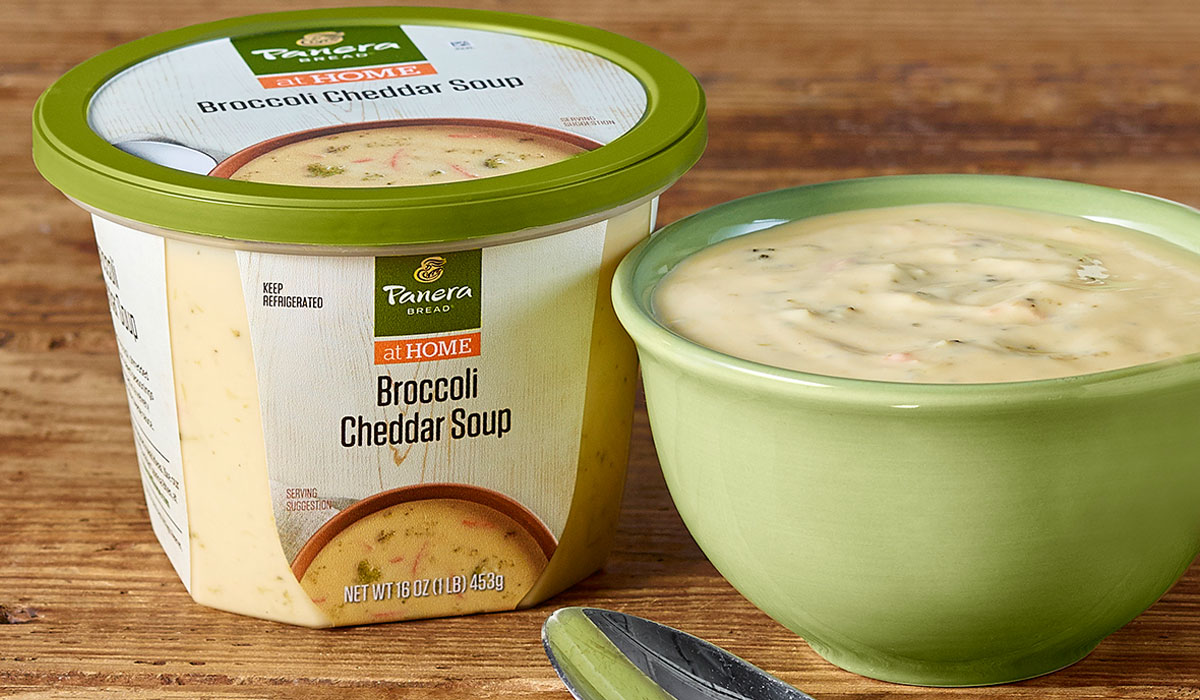In the past decade, Panera Bread witnessed a shift in consumer shopping behaviors, especially in the retail sector. Mike Bufano, Panera at Home’s senior vice president and general manager, refers to this as the “fresh perimeter.” The center aisle is shrinking as guests seek out better ingredients, fresher items, and products that mirror their day-to-day health values.
And this movement took them right to Panera, Bufano says.
On Thursday, the company announced that its retail sales for Panera at Home’s Refrigerated Soups exceeded $100 million in 2017, making the brand the first in the refrigerated soup category to surpass the milestone in annual sales, according to data from market research firm IRI. Panera at Home’s retail Refrigerated Soup sales hiked 27 percent in 2017, which was also tops among competitors in the segment.
Bufano says this can be credited to Panera’s firm standing in the discussion. “What Panera ultimately stands for in the customer’s mind—these ideas of 100 percent clean, food they know is craveabale; food they believe is good for them; and certainly food they trust, ‘Food As It Should Be,’ as our advertising slogan is—Panera fits that very well.”
When the company started Panera at Home, Bufano says it was about selling the brand and its products outside the restaurant. Leadership wasn’t really sure how it would evolve. Given how fast this segment has boomed, as diners look for single meals in addition to their weekly cart pile up, Panera was ahead of the curve.
And here’s where it stands today: The refrigerated soup category is $325 million, according to IRI—an 18 percent increase in the past year alone. Panera accounts for a substantial $113 million of that pie. Overall, including bread and salad dressings, Panera at Home is over $200 million in retail sales, with compounded annual growth rate of about 30 percent per year for the past five.
“I think, for us, what it really symbolizes is the fact that in the consumer’s mind Panera is not just a restaurant brand, it’s a food brand,” Bufano says. “And so much of what we’re doing in the bakery cafes resonates with people’s eating and shopping habits right now. And it tells me how much they trust the Panera brand.”
Someone recently asked Bufano where Panera at Home is getting the share from. It has to be taking share, doesn’t it? That’s what’s unique about fronting a category with this much growth, however. Bufano says customers are moving away from canned soup more than ever, and searching out these fresh products. And even fresh, Panera at Home’s Refrigerated Soups have shelf life of two months, which typically comes to about six or seven weeks from purchase date for consumers.
Unlike many other brands in this space, Panera also has the leverage of its more than 2,000 U.S. locations to pull from. Here’s a fact that doesn’t surprise Bufano: When a soup sells in the restaurant, it tends to fly off grocery shelves.
For example, the Broccoli Cheddar flavor is Panera’s bestseller in both formats. This year alone, customers purchased about 130 million cups of the soup in cafes and at home. Next is Baked Potato, Autumn Squash, and Creamy Tomato. Just like the restaurants.
“You can almost line them up side by side,” Bufano says. “What’s been nice about it that we’ve been able to see is that we think some of our customers are certainty people who also buy it in the bakery cafés, but then we can also innovate off that base that we have with those people.”
Panera at Home plans to innovate with a Southwest Corn Chowder and Minestrone Soup with Chickpeas and Kale this fall. Those won’t be in restaurants, but it wouldn’t be hard to imagine them there, either.
That equation is key to the success of this synergy. Panera at Home sells dressings and bread as well. Both these products make sense with the company’s name and logo printed on the front. Bufano says, like the soups, it comes down to trust. Bread is in the name, after all. Dressings and salads are right on par with soups as far as menu recognition.
Yet, something like deli meat, arriving cold, wouldn’t make sense.
“I don’t think the customer would look at that and say, ‘That looks like Panera to me.’ We have to be very careful with the equity when we think about other categories to enter,” Bufano says. “But we think we have a good sense of that, a really good sense of where our North Star lies, and we should be able to pick the right category to be able to continue to grow this business.”
Panera at Home offers more than 15 varieties of soup, including recent additions Turkey Sausage and Kale & Quinoa.
Additionally, Panera at Home has found success by offering recipes online to use the products, including a hot broccoli Cheddar bacon dip made with Bufano in mind referred to as Mike’s Dip.
Bufano says this has helped expand brand engagement through social media platforms like Pinterest and Instagram. “Part of the goal, the versatility, is just to get people to engage in it more and more and make it part of their everyday lives,” he says.













